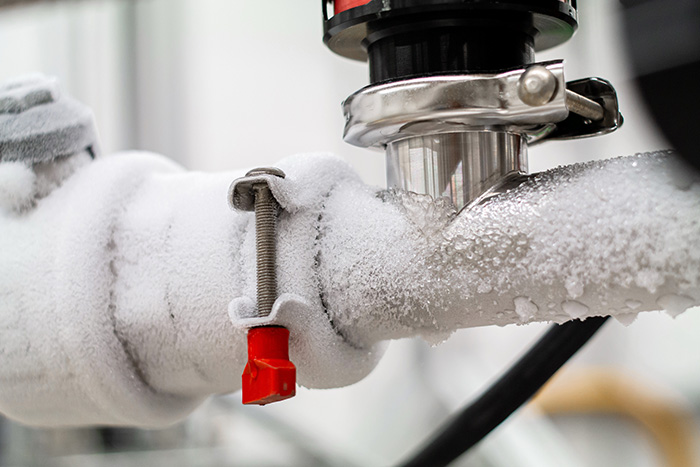Presented here further down you will discover a good deal of awesome insights concerning How to Prevent Your Pipes From Freezing.

Winter can wreak havoc on your pipes, specifically by freezing pipes. Right here's how to avoid it from taking place and what to do if it does.
Intro
As temperatures decrease, the danger of frozen pipes boosts, potentially bring about costly fixings and water damages. Recognizing how to stop icy pipes is important for house owners in cold climates.
Understanding Icy Pipes
What triggers pipes to ice up?
Pipelines freeze when revealed to temperature levels below 32 ° F (0 ° C) for prolonged durations. As water inside the pipelines freezes, it broadens, putting pressure on the pipeline wall surfaces and possibly creating them to rupture.
Dangers and damages
Icy pipes can result in water disturbances, building damage, and pricey fixings. Ruptured pipes can flooding homes and create extensive architectural damage.
Indicators of Frozen Pipeline
Identifying icy pipelines early can avoid them from rupturing.
How to determine frozen pipelines
Look for lowered water flow from faucets, uncommon odors or noises from pipelines, and noticeable frost on subjected pipes.
Prevention Tips
Shielding prone pipes
Cover pipelines in insulation sleeves or utilize warm tape to shield them from freezing temperature levels. Focus on pipelines in unheated or external areas of the home.
Home heating techniques
Maintain interior rooms adequately warmed, particularly locations with plumbing. Open up cupboard doors to enable cozy air to flow around pipes under sinks.
Safeguarding Outside Plumbing
Yard hose pipes and exterior faucets
Disconnect and drain garden tubes before winter. Mount frost-proof spigots or cover outdoor taps with insulated caps.
What to Do If Your Pipelines Freeze
Immediate actions to take
If you suspect icy pipelines, keep faucets open up to soothe pressure as the ice thaws. Use a hairdryer or towels soaked in hot water to thaw pipes slowly.
Long-Term Solutions
Structural modifications
Consider rerouting pipelines away from exterior walls or unheated locations. Add added insulation to attic rooms, cellars, and crawl spaces.
Updating insulation
Buy premium insulation for pipelines, attics, and wall surfaces. Proper insulation assists maintain regular temperatures and decreases the threat of frozen pipes.
Final thought
Preventing frozen pipes calls for proactive measures and quick actions. By understanding the causes, signs, and safety nets, property owners can secure their pipes throughout cold weather.
5 Ways to Prevent Frozen Pipes
Drain Outdoor Faucets and Disconnect Hoses
First, close the shut-off valve that controls the flow of water in the pipe to your outdoor faucet. Then, head outside to disconnect and drain your hose and open the outdoor faucet to allow the water to completely drain out of the line. Turn off the faucet when done. Finally, head back to the shut-off valve and drain the remaining water inside the pipe into a bucket or container. Additionally, if you have a home irrigation system, you should consider hiring an expert to clear the system of water each year.
Insulate Pipes
One of the best and most cost-effective methods for preventing frozen water pipes is to wrap your pipes with insulation. This is especially important for areas in your home that aren’t exposed to heat, such as an attic. We suggest using foam sleeves, which can typically be found at your local hardware store.
Keep Heat Running at 65
Your pipes are located inside your walls, and the temperature there is much colder than the rest of the house. To prevent your pipes from freezing, The Insurance Information Institute suggests that you keep your home heated to at least 65 degrees, even when traveling. You may want to invest in smart devices that can keep an eye on the temperature in your home while you’re away.
Leave Water Dripping
Moving water — even a small trickle — can prevent ice from forming inside your pipes. When freezing temps are imminent, start a drip of water from all faucets that serve exposed pipes. Leaving a few faucets running will also help relieve pressure inside the pipes and help prevent a rupture if the water inside freezes.
Open Cupboard Doors
Warm your kitchen and bathroom pipes by opening cupboards and vanities. You should also leave your interior doors ajar to help warm air circulate evenly throughout your home.

I was introduced to that write-up on Prevent Frozen Pipes from an associate on our other web page. For those who liked our blog entry kindly consider to pass it around. I appreciate reading our article about Preventing and dealing with frozen pipes.
Article